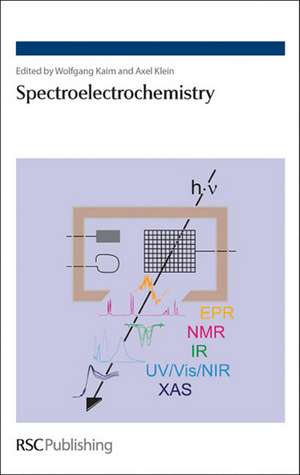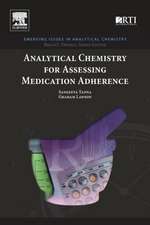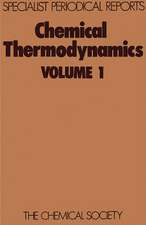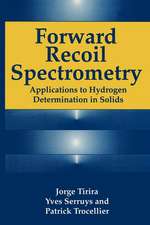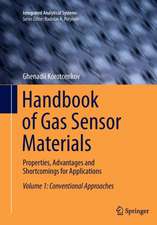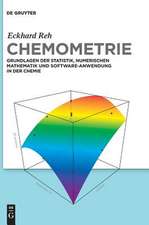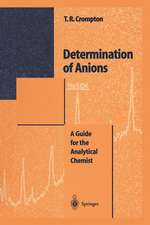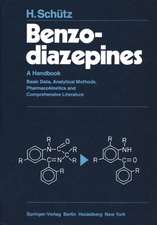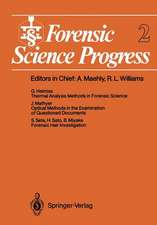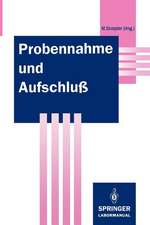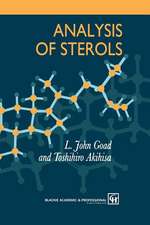Spectroelectrochemistry: Rsc
Autor Royal Society of Chemistry Editat de Wolfgang Kaim, Axel Kleinen Limba Engleză Hardback – 30 iun 2008
Electrochemistry affects several relevant research subjects of physics, chemistry and biology such as the transformation of materials, the transfer of information (especially in living systems), or the conversion and storage of energy. In addition, electrochemical processes constitute a major class of chemical reactions both in the laboratory and on large industrial scales. While conventional analytical electrochemistry provides excellent methods to determine concentrations (e.g. in sensor technology), to yield energy data in the form of redox potentials and to elucidate formal reaction mechanisms via kinetic analysis, these techniques alone are often not immediately suitable to identify unknown species which are formed as intermediates or as products in a redox reaction. The combination of reaction-oriented electrochemistry with species-focussed spectroscopy in spectroelectrochemistry can solve this problem and thus allow for a more complete analysis of electron transfer processes and complex redox reactions. Many research groups from various sub-fields of the chemical sciences have engaged in recent years in using and developing this combined methodology. While the technique has been well developed during the last few decades, its application in various fields of chemistry has only recently become more widespread. Readily accessible, inexpensive equipment and lower barriers to application have contributed to this situation and, at the same time, it is becoming less and less acceptable in chemical research to assign redox transformations without spectral evidence. Spectroelectrochemistry has therefore evolved as a powerful yet usually inexpensive technique which yields mechanistic (chemistry), energy-relevant (electro) as well as electronic structure information (spectro). The whole range of the electromagnetic spectrum can be employed from x-ray absorption to NMR spectroscopies. Yet while the method has become more commonplace, there are still aspects to be considered which require sound knowledge and experience. This book serves as a guide and as an illustration of the kind of research where spectroelectrochemistry can make a difference in the understanding of redox reactions through identification of their intermediates and products. Relevant examples involving UV-VIS-NIR and IR absorption spectroscopy as well as electron paramagnetic resonance (EPR) are presented in this book with the objective to illustrate the potential and the applications of this technique and to provide practical information. The topics covered include: " organometallics " coordination compounds (mixed-valent complexes, metalloporphyrins) " compounds of biochemical interest such as iron-containing proteins The breadth and variety of reactions and materials covered are complemented by the straightforward interpretation of results in the understanding of redox reactions. The solutions available from the spectroelectrochemical investigation in the book do not only provide simultaneous reaction analysis and species identification but also an assessment of electronic situations and of intra- and intermolecular electron transfer. The book aims to familiarise the scientific community with this method by describing the experimental approaches possible and by pointing out under what diverse circumstances this technique can be useful. This book is essential reading for experts and newcomers alike to acquaint themselves with this simple, inexpensive, yet powerful method and it will also appeal to scientists from all chemical sub-fields who have a basic understanding and experience in electrochemistry.
Preț: 779.51 lei
Preț vechi: 906.40 lei
-14% Nou
Puncte Express: 1169
Preț estimativ în valută:
149.18€ • 161.98$ • 125.31£
149.18€ • 161.98$ • 125.31£
Carte tipărită la comandă
Livrare economică 22 aprilie-06 mai
Preluare comenzi: 021 569.72.76
Specificații
ISBN-13: 9780854045501
ISBN-10: 0854045503
Pagini: 236
Ilustrații: 1
Dimensiuni: 160 x 236 x 20 mm
Greutate: 0.54 kg
Editura: Royal Society Of Chemistry
ISBN-10: 0854045503
Pagini: 236
Ilustrații: 1
Dimensiuni: 160 x 236 x 20 mm
Greutate: 0.54 kg
Editura: Royal Society Of Chemistry
Cuprins
Chapter 1: Infrared Spectroelectrochemistry; Chapter 2: UV-visible spectroelectrochemistry of Selected Iron Containing Proteins; Chapter 3: Mixed-valent Intermediates as Ideal Targets for Spectroelectrochemistry (SEC); Chapter 4: Spectroelectrochemistry of Metalloporphyrins;Chapter 5: Infrared Spectroelectrochemical Investigations of Ultrafast Electron Transfer in Mixed Valence Complexes;Chapter 6: Spectroelectrochemical Investigations on Carbon Rich Organometallic Complexes;Chapter 7: EPR Spectroelectrochemistry;
Notă biografică
Wolfgang Kaim is currently at the University of Stuttgart. His background and qualifications are in physical organometallic chemistry of main group and transition elements and his research interests are in redox reactions, including biomimetic systems. Axel Klein is at the University of Koln and his research interests include the design of transition metal complexes for various purposes such as (electro)catalysis, luminescence, or photochemistry and the investigation of highly reactive intermediates
Textul de pe ultima copertă
Electrochemistry affects several relevant research subjects of physics, chemistry and biology such as the transformation of materials, the transfer of information (especially in living systems), or the conversion and storage of energy. In addition, electrochemical processes constitute a major class of chemical reactions both in the laboratory and on large industrial scales. While conventional analytical electrochemistry provides excellent methods to determine concentrations (e.g. in sensor technology), to yield energy data in the form of redox potentials, and to elucidate formal reaction mechanisms via kinetic analysis, these techniques alone are often not immediately suitable to identify unknown species which are formed as intermediates or as products in a redox reaction. The combination of reaction-oriented electrochemistry with species-focussed spectroscopy in spectroelectrochemistry can solve this problem, and many research groups from various sub-fields of the chemical sciences have engaged in recent years in using and developing this combined methodology. Spectroelectrochemistry has therefore evolved as a powerful yet usually inexpensive technique which yields mechanistic (chemistry), energy-relevant (electro) as well as electronic structure information (spectro). The whole range of the electromagnetic spectrum can be employed from x-ray absorption to NMR spectroscopies. Relevant examples involving UV-VIS-NIR and IR absorption spectroscopy as well as electron paramagnetic resonance (EPR) are presented in this book with the objective to illustrate the potential and the applications of this technique and to provide practical information. The breadth and variety of reactions and materials covered are complemented by the straightforward interpretation of results in the understanding of redox reactions. Spectroelectrochemistry is essential reading for experts and newcomers alike to acquaint themselves with this simple, inexpensive, yet powerful method and it will also appeal to scientists from all chemical sub-fields who have a basic understanding and experience in electrochemistry.
Descriere
A practical guidebook illustrating the applications of spectroelectrochemistry to the understanding of redox reactions through identification of their intermediaries and products.
